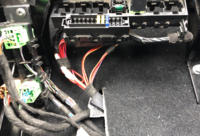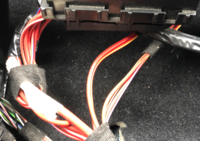Installing 12v Socket /s - How Its Done -
Another popular hot topic is Power or more commonly 12v outlet sockets, so i thought i would put together some details on how it can be done.
The first thing you need to do is work out what you want and where . . . .
various 12v sockets are available, here are a few options.

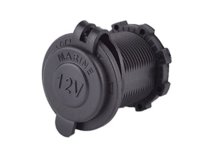
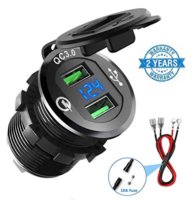
They all work on the same principle, they all need a +12v feed wire and a 0v ground wire.
so you have two options:
1: run a 2core cable from the source to the socket
or
2: run a 1core cable from the source and use a 0v body ground close to the socket.
here is an example of a pre-made 2core, fused cable with floating socket at the end. (you could cut off the socket and fit your own)
.

So you need to run an appropriate size cable to the rear socket location, either 2core or 1core+body ground. But what size cable and what size fuse?
You need to fuse the cable at the source with the appropriate rated fuse, Why? well to protect the cable. In the event of a dead-short say from a collision a dead-short could set fire to the cable - which is very bad!
The above example uses Cable: SPT-2 2/C 16AWG, 10FT Red & Black Heavy Duty 100% Copper Wire. and uses a 15A fuse. - remember you can always you UP in cable size/rating and DOWN in fuse size/rating. but must never go DOWN in cable size and UP in fuse size. - always protect the cable with a good safety margin and down rate the fuse by 25% or more.
******************************
some average cables sizes used are:
Conductor Cross Section(mm²)
0.5mm - 11Amps,
0.75mm - 14A
1.0mm - 16.5A
1.5mm - 21A
2.0mm - 25A
2.5mm - 28A
3.0mm – 33A
4.0mm – 39A
6.0mm – 50A
8.5mm – 63A
10mm - 70A
16mm - 110A
25mm - 170A
35mm - 240A
50mm – 345A
70mm – 485A
95mm – 500A
******************************
18AWG/ (Wire Diameter) 1.02mm / (Cross Secition area) 0.8mm2
16AWG/ (Wire Diameter) 1.29mm / (Cross Secition area) 1.3mm2
12AWG/ (Wire Diameter) 2.05mm / (Cross Secition area) 3.3mm2
10AWG/ (Wire Diameter) 2.59mm / (Cross Secition area) 5.2mm2
******************************
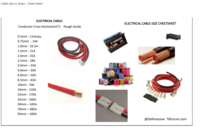

 www.t6forum.com
www.t6forum.com
******************************

******************************
heres an example:


****************************
heres a detailed look at some 1.5mm2 . . . .

****************************

as as a rough guide the longer the cable run is the thicker the cable needs to be, why? well volt drop!
Volt drop can be an issue when you are trying to pull larger current for larger loads, say a winch or tyre inflator or AMP or 12v fridge or anything else. Its like the water through a pipe analogy. A Fatter pipe lets more water through than a thin pipe right - at a set pressure. well a fatter wire has less resistance to current flow so allows more juice to flow.
So again if you want to run more than just a USB charger from the socket then look at running in the thicker cable, see where we are going with this . . . . . . longer run = thicker cable, larger loads = thicker cable, multiple loads = thicker cable.
Suitable cable to the length required may be 1mm, 1.5mm, 2.0mm, 2.5mm or larger.
a battery cable for example could be 2AWG/4AWG 6.6mm and handle 100-150A.
Now Fuses:

The Fuse is there to protect the cable and must be fitted as close to the source as possible, the above chart show some relations, but to keep things simple we are looking at fuses of 1-15A for the cable we are looking to run in.
As a guide the 12v socket fuse would be down rated to 10Amp if the cable/length could carry 15A. - why? - we again we want to stay safe. if you run the 15amp cable and draw 15amps through it there will be a very good chance the cable will start to heat-up and possibly melt the cable/fuse/fuse holder/connection. So we always down rate the fuse to a safe level to protect the whole cable run.
If you plug in a device that requires more than the 10A fuse and it blows then that tells you that you need a beefier supply cable that can handle say 20A and down rate that fuse to say 15A. (Note- most 12v sockets are rated at 15A max and WILL start to get HOT during use above 10A due to the small surface area of the connection points within the socket. other plug/socket combos are recommended for higher loads for example - Anderson plugs)
Where do we take the source from? - well you have a few options depending on your setup.
Connect the fused cable to either:
Starter battery, (engine bay)
Ignition supply, (central glove box under dash)
Leisure battery, (under front seat/s if fitted)
direct battery connections (starter or Leisure) can be done with ring terminals with a fuse within a few inches of the battery post like this . . . . (remember not to bridge-out the T6 battery current shunt on the starter battery -ve post - use a suitable ground point)
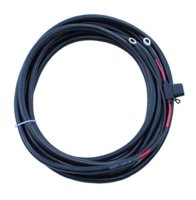
You can also pick up an ignition feed or starter battery feed from the central dash fuse box using new fuse pins and populate empty OEM fuse locations OR you can tap onto existing fuse locations using a fuse-buddy like below (observe the correct way round to fit the fuse buddy so the outgoing leg is actually fused) . . . . . . . . .
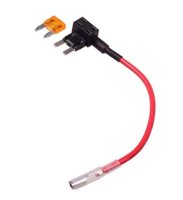
Be mindful not to leave things plugged in that will drain the battery flat and damage it. (you could fit a low-voltage battery disconnect if you were very forgetful)
If you needed more power/current or more sockets, then the supply cable/fuse needs to be increased accordingly. Or just run multiple feeds out to various sockets all separate with separate fuses Etc.
Also remember that if you plan to use any inline on/off switches then you need to make sure that "Amp rating of the switch contacts" are inline with above, ie use a switch that can handle at least 15A DC on your 10A circuit. . . . again over-rate the switch to stay safe.
*********************************************************************
Examples:
Twin cable (Flat 2 Core 1.5mm² 21Amps, 5 Metres) 5Metre - https://amzn.to/35V5nY4
Twin cable (Flat 2 Core 2.0mm² 25Amps, 5 Metres) - https://amzn.to/393hDYp
Twin cable (Flat 2 Core 3.0mm² 33Amps, 5 Metres) - Wire4u 12V 24V AUTOMOTIVE 2/3/4/5/7 CORE THINWALL RED/BLACK CAR CABLE WIRE ROUND/FLAT (Flat 2 Core 3.0mm² 33Amps, 5 Metres): Amazon.co.uk: Car & Motorbike
Round Twin 2 Core Cable 12v 24v Thin Wall Wire (25 AMP Rated 2mm²) 10 Metre - Round Twin 2 Core Cable 12v 24v Thin Wall Wire (25 AMP Rated 2mm²) 10 Metre: Amazon.co.uk: Car & Motorbike
Single cable 1.5mm² - Car Electrical Wire, Set of 2 Colours (Red/Black) at 5m - https://amzn.to/2MnDhx4
Single cable 2.5mm² - Car Electrical Wire, Set of 2 Colours (Red/Black) at 5m - DCSk - Vehicle cable type FLRY B asymmetrical 2.5mm²: Amazon.co.uk: Electronics
6 Way Blade Fuse Box with LED Indicator for Car Boat Van - https://amzn.to/2sSFCcr
12 Way Blade Fuse Box/Bus Bar With Cover - https://amzn.to/2MmWtec
5 Gang Toggle Switch Panel, Dual USB Socket Charger 12V Power Outlet LED Voltmeter -
https://amzn.to/35MsHqV
.
**********************************************************************
12v Igntn Feed + 5xusb Charging From Ign Feed - Today's Install
.
12v Aux Feed + 5xusb Charging From Aux Battery - Today's Install
Dellmassive`s -- "how I Done It" -- Thread
***********************************************************************
***********************************************************************
Another popular hot topic is Power or more commonly 12v outlet sockets, so i thought i would put together some details on how it can be done.
The first thing you need to do is work out what you want and where . . . .
various 12v sockets are available, here are a few options.



They all work on the same principle, they all need a +12v feed wire and a 0v ground wire.
so you have two options:
1: run a 2core cable from the source to the socket
or
2: run a 1core cable from the source and use a 0v body ground close to the socket.
here is an example of a pre-made 2core, fused cable with floating socket at the end. (you could cut off the socket and fit your own)
.

So you need to run an appropriate size cable to the rear socket location, either 2core or 1core+body ground. But what size cable and what size fuse?
You need to fuse the cable at the source with the appropriate rated fuse, Why? well to protect the cable. In the event of a dead-short say from a collision a dead-short could set fire to the cable - which is very bad!
The above example uses Cable: SPT-2 2/C 16AWG, 10FT Red & Black Heavy Duty 100% Copper Wire. and uses a 15A fuse. - remember you can always you UP in cable size/rating and DOWN in fuse size/rating. but must never go DOWN in cable size and UP in fuse size. - always protect the cable with a good safety margin and down rate the fuse by 25% or more.
******************************
some average cables sizes used are:
Conductor Cross Section(mm²)
0.5mm - 11Amps,
0.75mm - 14A
1.0mm - 16.5A
1.5mm - 21A
2.0mm - 25A
2.5mm - 28A
3.0mm – 33A
4.0mm – 39A
6.0mm – 50A
8.5mm – 63A
10mm - 70A
16mm - 110A
25mm - 170A
35mm - 240A
50mm – 345A
70mm – 485A
95mm – 500A
******************************
18AWG/ (Wire Diameter) 1.02mm / (Cross Secition area) 0.8mm2
16AWG/ (Wire Diameter) 1.29mm / (Cross Secition area) 1.3mm2
12AWG/ (Wire Diameter) 2.05mm / (Cross Secition area) 3.3mm2
10AWG/ (Wire Diameter) 2.59mm / (Cross Secition area) 5.2mm2
******************************


Diagrams, Schematics & Wires -- How I Done It --
Diagrams, Schematics & Wires -- How I Done It -- ************************************************** Dellmassive`s -- "how I Done It" -- Thread ************************************************** Kit List And Stuff -- How I Done It & What I Use --...
******************************

******************************
heres an example:


****************************
heres a detailed look at some 1.5mm2 . . . .

****************************

as as a rough guide the longer the cable run is the thicker the cable needs to be, why? well volt drop!
Volt drop can be an issue when you are trying to pull larger current for larger loads, say a winch or tyre inflator or AMP or 12v fridge or anything else. Its like the water through a pipe analogy. A Fatter pipe lets more water through than a thin pipe right - at a set pressure. well a fatter wire has less resistance to current flow so allows more juice to flow.
So again if you want to run more than just a USB charger from the socket then look at running in the thicker cable, see where we are going with this . . . . . . longer run = thicker cable, larger loads = thicker cable, multiple loads = thicker cable.
Suitable cable to the length required may be 1mm, 1.5mm, 2.0mm, 2.5mm or larger.
a battery cable for example could be 2AWG/4AWG 6.6mm and handle 100-150A.
Now Fuses:

The Fuse is there to protect the cable and must be fitted as close to the source as possible, the above chart show some relations, but to keep things simple we are looking at fuses of 1-15A for the cable we are looking to run in.
As a guide the 12v socket fuse would be down rated to 10Amp if the cable/length could carry 15A. - why? - we again we want to stay safe. if you run the 15amp cable and draw 15amps through it there will be a very good chance the cable will start to heat-up and possibly melt the cable/fuse/fuse holder/connection. So we always down rate the fuse to a safe level to protect the whole cable run.
If you plug in a device that requires more than the 10A fuse and it blows then that tells you that you need a beefier supply cable that can handle say 20A and down rate that fuse to say 15A. (Note- most 12v sockets are rated at 15A max and WILL start to get HOT during use above 10A due to the small surface area of the connection points within the socket. other plug/socket combos are recommended for higher loads for example - Anderson plugs)
Where do we take the source from? - well you have a few options depending on your setup.
Connect the fused cable to either:
Starter battery, (engine bay)
Ignition supply, (central glove box under dash)
Leisure battery, (under front seat/s if fitted)
direct battery connections (starter or Leisure) can be done with ring terminals with a fuse within a few inches of the battery post like this . . . . (remember not to bridge-out the T6 battery current shunt on the starter battery -ve post - use a suitable ground point)

You can also pick up an ignition feed or starter battery feed from the central dash fuse box using new fuse pins and populate empty OEM fuse locations OR you can tap onto existing fuse locations using a fuse-buddy like below (observe the correct way round to fit the fuse buddy so the outgoing leg is actually fused) . . . . . . . . .

Be mindful not to leave things plugged in that will drain the battery flat and damage it. (you could fit a low-voltage battery disconnect if you were very forgetful)
If you needed more power/current or more sockets, then the supply cable/fuse needs to be increased accordingly. Or just run multiple feeds out to various sockets all separate with separate fuses Etc.
Also remember that if you plan to use any inline on/off switches then you need to make sure that "Amp rating of the switch contacts" are inline with above, ie use a switch that can handle at least 15A DC on your 10A circuit. . . . again over-rate the switch to stay safe.
*********************************************************************
Examples:
Twin cable (Flat 2 Core 1.5mm² 21Amps, 5 Metres) 5Metre - https://amzn.to/35V5nY4
Twin cable (Flat 2 Core 2.0mm² 25Amps, 5 Metres) - https://amzn.to/393hDYp
Twin cable (Flat 2 Core 3.0mm² 33Amps, 5 Metres) - Wire4u 12V 24V AUTOMOTIVE 2/3/4/5/7 CORE THINWALL RED/BLACK CAR CABLE WIRE ROUND/FLAT (Flat 2 Core 3.0mm² 33Amps, 5 Metres): Amazon.co.uk: Car & Motorbike
Round Twin 2 Core Cable 12v 24v Thin Wall Wire (25 AMP Rated 2mm²) 10 Metre - Round Twin 2 Core Cable 12v 24v Thin Wall Wire (25 AMP Rated 2mm²) 10 Metre: Amazon.co.uk: Car & Motorbike
Single cable 1.5mm² - Car Electrical Wire, Set of 2 Colours (Red/Black) at 5m - https://amzn.to/2MnDhx4
Single cable 2.5mm² - Car Electrical Wire, Set of 2 Colours (Red/Black) at 5m - DCSk - Vehicle cable type FLRY B asymmetrical 2.5mm²: Amazon.co.uk: Electronics
6 Way Blade Fuse Box with LED Indicator for Car Boat Van - https://amzn.to/2sSFCcr
12 Way Blade Fuse Box/Bus Bar With Cover - https://amzn.to/2MmWtec
5 Gang Toggle Switch Panel, Dual USB Socket Charger 12V Power Outlet LED Voltmeter -
https://amzn.to/35MsHqV
.
**********************************************************************
12v Igntn Feed + 5xusb Charging From Ign Feed - Today's Install
.
12v Aux Feed + 5xusb Charging From Aux Battery - Today's Install
Dellmassive`s -- "how I Done It" -- Thread
***********************************************************************
***********************************************************************
Last edited:

